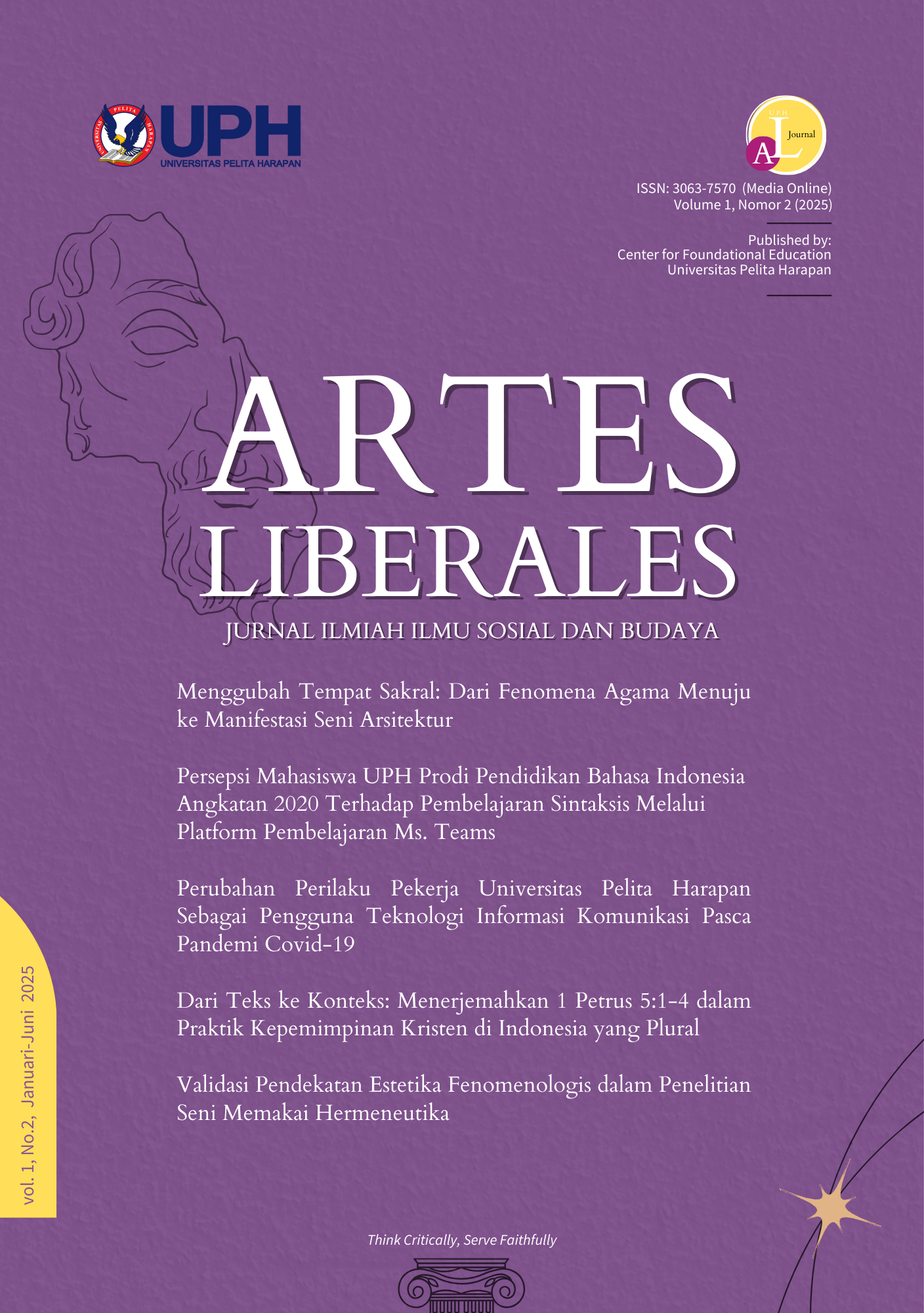Perubahan Perilaku Pekerja Universitas Pelita Harapan sebagai Pengguna Teknologi Informasi Komunikasi Pasca Pandemi Covid-19
Keywords:
Perubahan perilaku, cara kerja, integrasi teknologi, teknologi masif, covid-19Abstract
Abstract
The COVID-19 has caused changes in people's routines. Employees who must complete office-related work from home encounter this. Workers are looking for remote employment opportunities. The application of already developed technology is growing. The benefits of technology that were seen during COVID-19 are now indisputable and help advance ongoing human endeavors. This research employs a qualitative method in conjunction with phenomenological techniques. Subject interviews and literature reviews were used to collect data. Employees of UPH who have been employed there from before the pandemic until the present serve as the research's informants. The purpose of this study is to learn how the pandemic uses of information and communication technology brings employees in the UPH student affairs department to alter their behavior. Workers adjust their work behavior to address the issues that arise. According to the research findings, the process starts with knowledge, understanding the situation; then moves to persuasion, which is supported by conditions; decision-making, figuring out whether change takes place; implementation, using technology to change work behavior more widely; and confirmation, knowing how to work from pre-pandemic, during the pandemic, and post-pandemic. Technology that can help workers in finishing tasks is integrated with methods of working.
Abstrak
Pandemi COVID-19 menyebabkan perubahan dalam aktivitas manusia. Hal ini dirasakan oleh pekerja, karena terpaksa untuk melakukan kegiatan kantor dari rumah. Pekerja mencari cara untuk melakukan pekerjaannya dari rumah. Penggunaan teknologi yang sebelumnya sudah berkembang, menjadi semakin dimanfaatkan. Manfaat teknologi yang dirasakan ketika COVID-19 hingga saat ini menjadi pendukung aktivitas manusia yang terus dikembangkan dan tidak bisa dilepaskan. Penelitian ini menggunakan pendekatan kualitatif dengan metode fenomenologi. Pengumpulan data dari penelitian dilakukan dengan melakukan wawancara beserta kajian literatur. Informan pada penelitian ini adalah pekerja di Universitas Pelita Harapan yang sudah bekerja dari sebelum pandemi COVID-19, hingga saat ini. Tujuan dari penelitian ini adalah untuk mengetahui proses perubahan perilaku yang terjadi pada pekerja di departemen kemahasiswaan UPH sebagai pengguna teknologi informasi dan komunikasi akibat masa pandemi. Masalah yang terjadi akibat munculnya COVID-19 membuat pekerja perlu merubah dan menyesuaikan perilaku kerjanya. Hasil penelitian menunjukkan bahwa proses yang terjadi dari tahapan knowledge, pemahaman keadaan; persuasion, yang didukung dari kondisi; decision, memutuskan perubahan terjadi; implementation, tahap merubah perilaku bekerja semakin masif menggunakan teknologi; dan confirmation, tahapan setelah mengetahui cara kerja dari sebelum pandemi, ketika pandemi, hingga pasca pandemi. Pekerja melakukan integrasi terhadap cara kerja yang dipadukan dengan teknologi yang dapat membantu pekerja dalam menyelesaikan pekerjaan.
References
DAFTAR PUSTAKA
Badudu, J. S., & Zain, S. M. (1996). Kamus Umum Bahasa Indonesia. Pustaka Sinar Harapan.
Bovee, C. L., & Thill, J. V. (2003). Komunikasi Bisnis (6 ed.). Indeks Kelompok Gramedia.
Creswell, J. W. (2009). Research Design: Qualitative, Quantitative, and Mixed Methods Approaches. SAGE Publications.
Cummings, S., Bridgman, T., & Brown, K. G. (2016). Unfreezing change as three steps: Rethinking Kurt Lewin’s legacy for change management. Human Relations, 69(1), 33–60. https://doi.org/10.1177/0018726715577707
Gillis, J. R., Diamond, S. L., Jebely, P., Orekhovsky, V., Ostovich, E. M., MacIsaac, K., Sagrati, S., & Mandell, D. (2006). Systemic obstacles to battered women’s participation in the judicial system: when will the status quo change? Violence against Women, 12(12), 1150–1168. https://doi.org/10.1177/1077801206293500
Karman, S. A. (2022). Komunika: Jurnal Ilmu Komunikasi Teknologi Digital dalam Budaya Kerja: Refleksi Penggunaan Video Conference Platform Saat Pandemi Covid-19. Jurnal Ilmu Komunikasi, 9(1), 63–75. https://doi.org/10.22236/komunika.v9i1.7868
Lewin, K. (1947). Group decision and social change (Newcomb TM). Henry Holt.
Lunenburg, F. (2010). Formal Communication Channels: Upward, Downward, Horizontal, and External. FOCUS on Colleges, Universities & Schools, 4(1), 1–8. http://www.nationalforum.com/Electronic Journal Volumes/Lunenburg, Fred C, Formal Comm Channels FOCUS V4 N1 2010.pdf
Muslim, M. (2020). PHK pada Masa Pandemi Covid-19. ESENSI: Jurnal Manajemen Bisnis, 23(3), 357–370. https://www.worldometers.info/coronavirus
Rogers, E. M. (1983). DIFFUSION OF INNOVATIONS. In Achieving Cultural Change in Networked Libraries (Third Edit). The Free Press.
Sarumpaet, A. (2023). Pelaksanaan ketentuan work from homedalam perjanjian kerja bersama pt cimb niaga tbk. SELISIK, 9(1), 66–90. https://journal.univpancasila.ac.id/index.php/selisik/article/view/5219
Satriyono, G., Rukmini, M., Septyaningtyas, D. R., Manajemen, P. S., Kadiri, U., Studi, P., Sektor, A., & Kadiri, U. (2022). Studi Eksplorasi Dampak Work From Home ( Wfh ) Terhadap Kinerja Dosen Selama Pandemi Covid-19. 6, 3871–3877.
Syahrial. (2020). Dampak Covid-19 terhadap Tenaga Kerja. Jurnal Ners, 4(2), 21–29.
Thurlow, C., Lengel, L., & Tomic, A. (2004). Computer Mediated Communication. SAGE Publications. https://books.google.co.id/books?id=bNaDc7EXJloC
West, R., & Turner, L. H. (2010). Introducing Communication Theory (Fourth Edi). McGraw-Hill.
Downloads
Published
Issue
Section
License
Copyright (c) 2025 Sianne Tania , Rose

This work is licensed under a Creative Commons Attribution-ShareAlike 4.0 International License.
Authors who publish with this journal agree to the following terms:
1) Authors retain copyright and grant the journal right of first publication with the work simultaneously licensed under a Creative Commons Attribution License (CC-BY-SA 4.0) that allows others to share the work with an acknowledgement of the work's authorship and initial publication in this journal.
2) Authors are able to enter into separate, additional contractual arrangements for the non-exclusive distribution of the journal's published version of the work (e.g., post it to an institutional repository or publish it in a book), with an acknowledgement of its initial publication in this journal.
3) Authors are permitted and encouraged to post their work online (e.g., in institutional repositories or on their website). The final published PDF should be used and bibliographic details that credit the publication in this journal should be included.”

